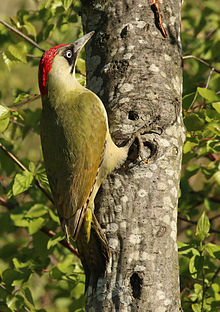Yaffle
| European green woodpecker | |
|---|---|
 |
|
| Female
Yaffle call of the Green Woodpecker, recorded in Surrey in 1977
|
|
| Scientific classification | |
| Kingdom: | Animalia |
| Phylum: | Chordata |
| Class: | Aves |
| Order: | Piciformes |
| Family: | Picidae |
| Genus: | Picus |
| Species: | P. viridis |
| Binomial name | |
|
Picus viridis Linnaeus, 1758 |
|
 |
|
| Range | |
The European green woodpecker (Picus viridis) is a member of the woodpecker family Picidae. There are four subspecies and it occurs in most parts of Europe and in western Asia. All have green upperparts, paler yellowish underparts, a red crown and moustachial stripe which has a red centre in males but is all black in females.
The European green woodpecker spends much of its time feeding on ants on the ground and does not often 'drum' on trees like other woodpecker species. It is a shy bird but usually draws attention with its loud calls. A nest hole is excavated in a tree; four to six eggs are laid which hatch after 19–20 days.
The European green woodpecker measures 30–36 cm in length with a 45–51 cm wingspan. Both sexes are green above and pale yellowish green below, with yellow rump and red crown and nape; the moustachial stripe has a red centre in the male but is solid black in the female. The lores and around the white eye are black in both male and female, except in the Iberian race P. v. subsp. sharpei, in which it is dark grey and males have only a lower black border to the moustache. Juveniles are spotty and streaked all over; the moustache is dark initially, though juvenile males can show some red feathers by early June or usually by July or August.
Moult takes place between June and November with the first flight feathers being lost around the time the young fledge. Juveniles moult quickly after fledging and gain their adult plumage between August and November.
Although the European green woodpecker is shy and wary, it is usually its loud calls, known as yaffling, which first draw attention. It 'drums' rarely (a soft, fast roll), but often gives a noisy kyü-kyü-kyück while flying. The song is a loud series of 10-18 'klü' sounds which gets slightly faster towards the end and falls slightly in pitch. The female makes a thinner pü-pü-pü-pü-pü-pü-pü. The flight is undulating, with 3–4 wingbeats followed by a short glide when the wings are held by the body.
It can be distinguished from the similar, but smaller, grey-headed woodpecker by its yellowish, not grey, underparts, and the black lores and facial 'mask'. In Europe, its green upperparts and yellow rump can lead to confusion with the grey-headed woodpecker or possibly the female golden oriole, though the latter is smaller and more slender with narrower wings and longer tail. The closely related, very similar Levaillant's woodpecker occurs only in north-west Africa.
...
Wikipedia

